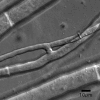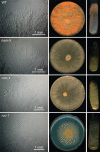The ham-5, rcm-1 and rco-1 genes regulate hyphal fusion in Neurospora crassa
- PMID: 20522492
- PMCID: PMC3068686
- DOI: 10.1099/mic.0.040147-0
The ham-5, rcm-1 and rco-1 genes regulate hyphal fusion in Neurospora crassa
Abstract
Mutants of Neurospora crassa unable to participate in vegetative hyphal fusion (anastomosis) were isolated and characterized. From this analysis, three genes, rcm-1, rco-1 and ham-5, were identified and shown to be required for hyphal fusion. The rcm-1 and rco-1 genes are homologues of the Saccharomyces cerevisiae SSN6 and TUP1 genes, which encode a dimeric transcription factor in yeast. We demonstrate that in N. crassa the rcm-1 and rco-1 genes are required for hyphal fusion and normal hyphal morphology, and influence both asexual and sexual development. The ham-5 gene encodes a 1686 amino acid protein with two putative WD40 domains, which might participate in protein-protein interactions. ham-5 deletion mutants had a reduced rate of hyphal extension and altered hyphal morphology, and were unable to produce the conidial anastomosis tubes that are required for hyphal fusion during colony initiation.
Figures




References
-
- Bistis, G. N. (1981). Chemotropic interactions between trichogynes and conidia of opposite mating-type in Neurospora crassa. Mycologia 73, 959–975.
-
- Bowman, S. M., Piwowar, A., Ciocca, M. & Free, S. J. (2005). Mannosyltransferase is required for cell wall biosynthesis, morphology and control of asexual development in Neurospora crassa. Mycologia 97, 872–879. - PubMed
-
- Bowman, S. M., Piwowar, A., Al Dabbous, M., Vierula, J. & Free, S. J. (2006). Mutational analysis of the glycosylphosphatidylinositol (GPI) anchor pathway demonstrates that GPI-anchored proteins are required for cell wall biogenesis and normal hyphal growth in Neurospora crassa. Eukaryot Cell 5, 587–600. - PMC - PubMed
-
- Davis, R. H. & De Serres, F. J. (1970). Genetic and microbial research techniques for Neurospora crassa. Methods Enzymol 17A, 79–143.
-
- Dohlman, H. G. & Thorner, J. W. (2001). Regulation of G protein-initiated signal transduction in yeast: paradigms and principles. Annu Rev Biochem 70, 703–754. - PubMed
Publication types
MeSH terms
Substances
Grants and funding
LinkOut - more resources
Full Text Sources
Molecular Biology Databases
Research Materials

